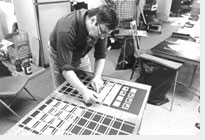

| Exhibition
| Chronology | Works
| Catalog
| Literature
| Press
| Trailer Visitor Information | Program | Partner | Credits | Deutsch |
|
Woody Vasulka  Woody Vasulka's artistic roots lie in documentary film. After moving to New York in 1969 he worked there with famous film artists on the extension of filmic possibilities on a technical basis: ranging from the development of new cameras to that of novel projectors. It was within this context that he first occupied himself with the medium of video. Since then, Vasulka has investigated the structure and materiality as well as extension possibilities of the electronic image [frame] by means of analogical or digital tools. Unlike anyone else, he researched the self-contained realm of apparatuses, and with this expertise he created altogether novel kinds of images, whose machine aesthetic overpowered their filmic one. His apparatus-images are as technically artificial as no images have ever been before. He repeatedly worked with Steina and other artists, but also together with technicians, programmers, and information technology developers. Formally as well as with respect to content, the narrative, syntactic, and metaphoric potential of electronic image production and processing moved into the center of his interest. For example, he investigated the relationship between electronic images and audio signals, which follow the same physical laws and could be worked with using the same technical devices. The initial results of his analyses were mostly technical studies, in the form of videos, screen image scans, and printouts. Later longer, independent and narrative video works were produced, such as The Commission [1983], or The Art of Memory [1987]. Through digital video processing and the algorithmic generation of images and beyond [the 1979 development of the »Digital Image Articulator«, together with J. Schier], he increasingly occupied himself with three-dimensional image creation, machine languages, and robotics. In the series of works Brotherhood [1990-98], he developed installations with interactive sound, image, and robot components. Woody Vasulka's artistic roots lie in documentary film. After moving to New York in 1969 he worked there with famous film artists on the extension of filmic possibilities on a technical basis: ranging from the development of new cameras to that of novel projectors. It was within this context that he first occupied himself with the medium of video. Since then, Vasulka has investigated the structure and materiality as well as extension possibilities of the electronic image [frame] by means of analogical or digital tools. Unlike anyone else, he researched the self-contained realm of apparatuses, and with this expertise he created altogether novel kinds of images, whose machine aesthetic overpowered their filmic one. His apparatus-images are as technically artificial as no images have ever been before. He repeatedly worked with Steina and other artists, but also together with technicians, programmers, and information technology developers. Formally as well as with respect to content, the narrative, syntactic, and metaphoric potential of electronic image production and processing moved into the center of his interest. For example, he investigated the relationship between electronic images and audio signals, which follow the same physical laws and could be worked with using the same technical devices. The initial results of his analyses were mostly technical studies, in the form of videos, screen image scans, and printouts. Later longer, independent and narrative video works were produced, such as The Commission [1983], or The Art of Memory [1987]. Through digital video processing and the algorithmic generation of images and beyond [the 1979 development of the »Digital Image Articulator«, together with J. Schier], he increasingly occupied himself with three-dimensional image creation, machine languages, and robotics. In the series of works Brotherhood [1990-98], he developed installations with interactive sound, image, and robot components.Woody Vasulka's continual artistic development ran parallel to the mediaís technical developmentóranging from analogic through digital image manipulation to interactive, machine-directed spatial installations. Even today, Vasulka is fascinated by the tools which enable novel control- and manipulation possibilities, thereby revealing each mediumís structure to the viewer. |
|